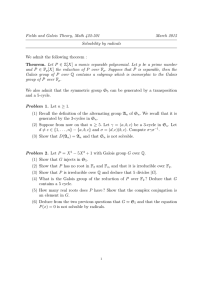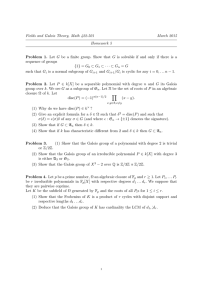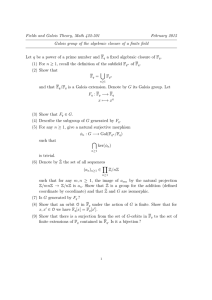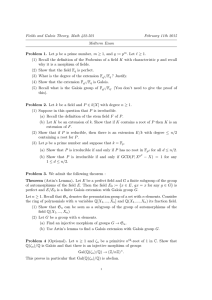Fields and Galois Theory, Math 422-501 March 2015 Review problems √
advertisement
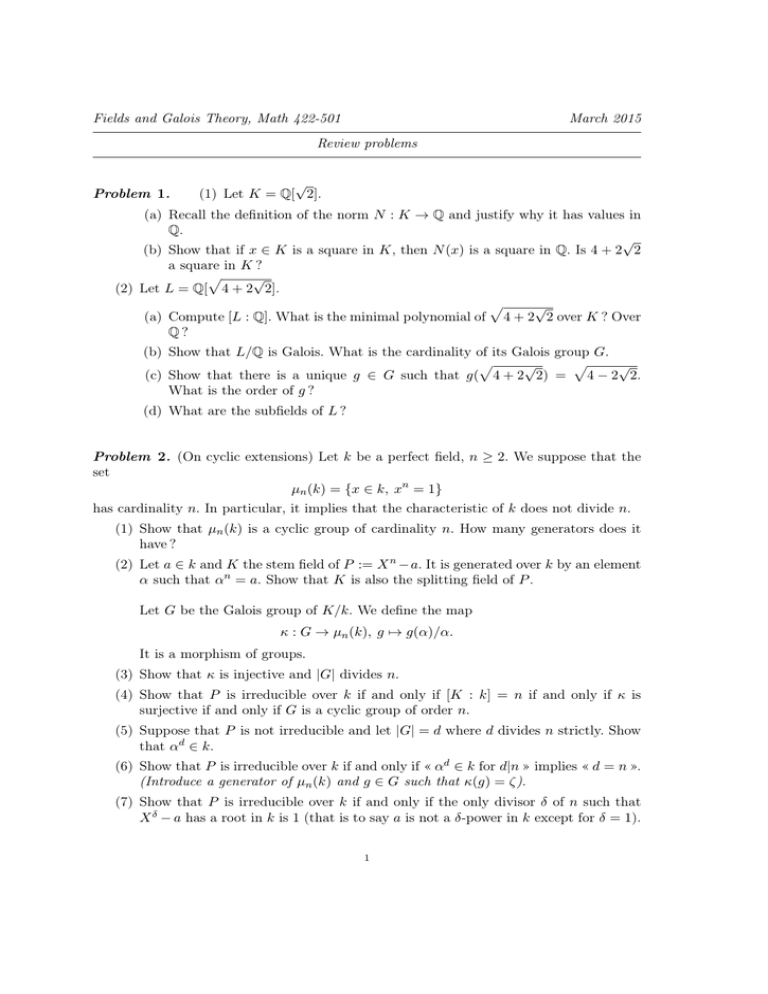
Fields and Galois Theory, Math 422-501
March 2015
Review problems
Problem 1.
√
(1) Let K = Q[ 2].
(a) Recall the definition of the norm N : K → Q and justify why it has values in
Q.
√
(b) Show that if x ∈ K is a square in K, then N (x) is a square in Q. Is 4 + 2 2
a square in K ?
p
√
(2) Let L = Q[ 4 + 2 2].
p
√
(a) Compute [L : Q]. What is the minimal polynomial of 4 + 2 2 over K ? Over
Q?
(b) Show that L/Q is Galois. What is the cardinality of its Galois group G.
p
p
√
√
(c) Show that there is a unique g ∈ G such that g( 4 + 2 2) = 4 − 2 2.
What is the order of g ?
(d) What are the subfields of L ?
Problem 2. (On cyclic extensions) Let k be a perfect field, n ≥ 2. We suppose that the
set
µn (k) = {x ∈ k, xn = 1}
has cardinality n. In particular, it implies that the characteristic of k does not divide n.
(1) Show that µn (k) is a cyclic group of cardinality n. How many generators does it
have ?
(2) Let a ∈ k and K the stem field of P := X n −a. It is generated over k by an element
α such that αn = a. Show that K is also the splitting field of P .
Let G be the Galois group of K/k. We define the map
κ : G → µn (k), g 7→ g(α)/α.
It is a morphism of groups.
(3) Show that κ is injective and |G| divides n.
(4) Show that P is irreducible over k if and only if [K : k] = n if and only if κ is
surjective if and only if G is a cyclic group of order n.
(5) Suppose that P is not irreducible and let |G| = d where d divides n strictly. Show
that αd ∈ k.
(6) Show that P is irreducible over k if and only if « αd ∈ k for d|n » implies « d = n ».
(Introduce a generator of µn (k) and g ∈ G such that κ(g) = ζ).
(7) Show that P is irreducible over k if and only if the only divisor δ of n such that
X δ − a has a root in k is 1 (that is to say a is not a δ-power in k except for δ = 1).
1
2
Problem 3. Let n ≥ 1 and ` a prime number. We say that m ∈ Z is not a `-power in a
subring A of C if the equation x` − m has no solution x ∈ A. We suppose that n is not a
`-power in Z.
Let ζ := e2iπ/` and K the splitting field of P = X ` − n over Q.
√
(1) Show that K = Q(ζ, ` n).
(2) Let x, y ∈ Q such that x`−1 = y ` . Show that x is a `-power in Q. If x ∈ Z, show
that x is a `-power in Z.
(3) Suppose that n is a `-power in Q[ζ]. Compute NQ(ζ)/Q (n) in two different ways and
find a contradiction.
(4) Show that P is irreducible over Q[ζ]. (Use the result of Problem 2)
(5) Let G be the Galois group of K over Q. Show that we have an exact sequence of
groups
0 → Z/`Z → G → (Z/`Z)× → 0.
Problem 4. Let n ≥ 1 and G = Z/nZ. Let K/Q a Galois extension with Galois group G
and x ∈ K generating K/Q. Le P be the minimal polynomial of x over Q.
(1) Why does x exist ?
(2) How many subfields L such that [K : L] = 2 does K contain ? Is L/K Galois ? If
yes what is its Galois group ?
(3) How many subfields L such that [L : Q] = 2 does K contain ? Is K/Q Galois ? If
yes what is its Galois group ?
Let σ ∈ Aut(C) be the complex conjugation.
(4) Show that σ(K) = K.
(5) Suppose that n is odd. Show that in the natural embedding G ,→ Sn , the group
G injects in An .
(6) Suppose that n is odd. Show that the restriction of σ to K is the identity.
(7) Suppose that n = 4, that K 6⊂ R and let L be the unique subfield of K of degree
2 over Q. Let L0 = K σ be the subfield of K of the √
elements fixed by σ. Show that
L = L0 and L ⊂ R. Deduce that if m ∈ Q satisfies m ∈ K then m ≥ 0.
Problem 5. Write the Galois group of X 16 − 1 over Q as a product of cyclic groups.
√
Problem 6. Let a ∈ Z. We want to show that the quadratic extension Q( a) of Q is
contained in a cyclotomic extension of Q.
(1) Show that it is true if a = −1 and a = 2.
(2) Let p be an odd prime number, ζ := e2iπ/p and K = Q(ζ). We identify the Galois
group of K with (Z/pZ)× .
P
i
k
(a) Show that
1≤i<p ζ = −1 and that B := {ζ }1≤k≤p−1 is a basis for the
Q-vector space K.
(b) Show that the subset H of the squares in (Z/pZ)× is a subgroup of index 2.
3
P
(c) Let x := h∈H h(ζ). Show that x has degree 2 over Q and give a formula for
its unique Q-conjugate x0 .
(d) Show that x + x0 = −1 and x2 + x ∈ Q. We want to compute this element
explicitly. Show that
X
X
x2 + x =
g(ζ) +
g(ζ)g 0 (ζ)
g∈H
g,g 0 ∈H
and that g(ζ) ∈ B. Under which condition do we have g(ζ)g 0 (ζ) = 1 ?
(i) Suppose that −1 ∈ H. Show that there is a family (ai )1≤i<p of elements
in Q such that
X
p−1
ai ζ i
x2 + x =
+
2
1≤i<p
P
2
and 1≤i<p ai = (p − 1) /4. Using (2)(a) show that x2 + x = (p − 1)/4
and find the value of x. What is Q(x)?
(ii) Suppose that −1 6∈ H. Show that there is a family (ai )1≤i<p of elements
in Q such that
X
ai ζ i
x2 + x =
1≤i<p
and 1≤i<p ai = (p − 1)(p + 1)/4. Using (2)(a) show that x2 + x =
−(p + 1)/4 and find the value of x. What is Q(x)?.
P
2iπ
(3) For n, m ≥ 1 show that Q(e2iπ/n , e2iπ/m ) ⊂ Q(e nm ).
(4) Conclude.
